Study Skills Report: Analysis of Hofstede's Cultural Dimensions
VerifiedAdded on 2020/11/23
|7
|1187
|167
Report
AI Summary
This report delves into Hofstede's cultural dimensions, a framework used to understand societal culture's impact on its members. It examines three key dimensions: individualism/collectivism, power distance, and uncertainty avoidance. The report agrees with the relevance of individualism/collectivism, emphasizing the importance of individual contributions and group cohesion. It suggests prioritizing a low individualism score to enhance organizational coordination and decision-making. Conversely, the report disagrees with the uncertainty avoidance dimension, highlighting its potential disadvantages, such as rigid rules and resistance to innovation. The report recommends focusing on the power distance index, advocating for lower power distance to foster democratic practices, open communication, and innovative ideas within organizations. This promotes quicker decision-making and increased efficiency. The study concludes that understanding these cultural dimensions is crucial for organizational behavior and leadership, offering valuable insights into navigating diverse cultural landscapes. Explore similar assignments and past papers on Desklib.
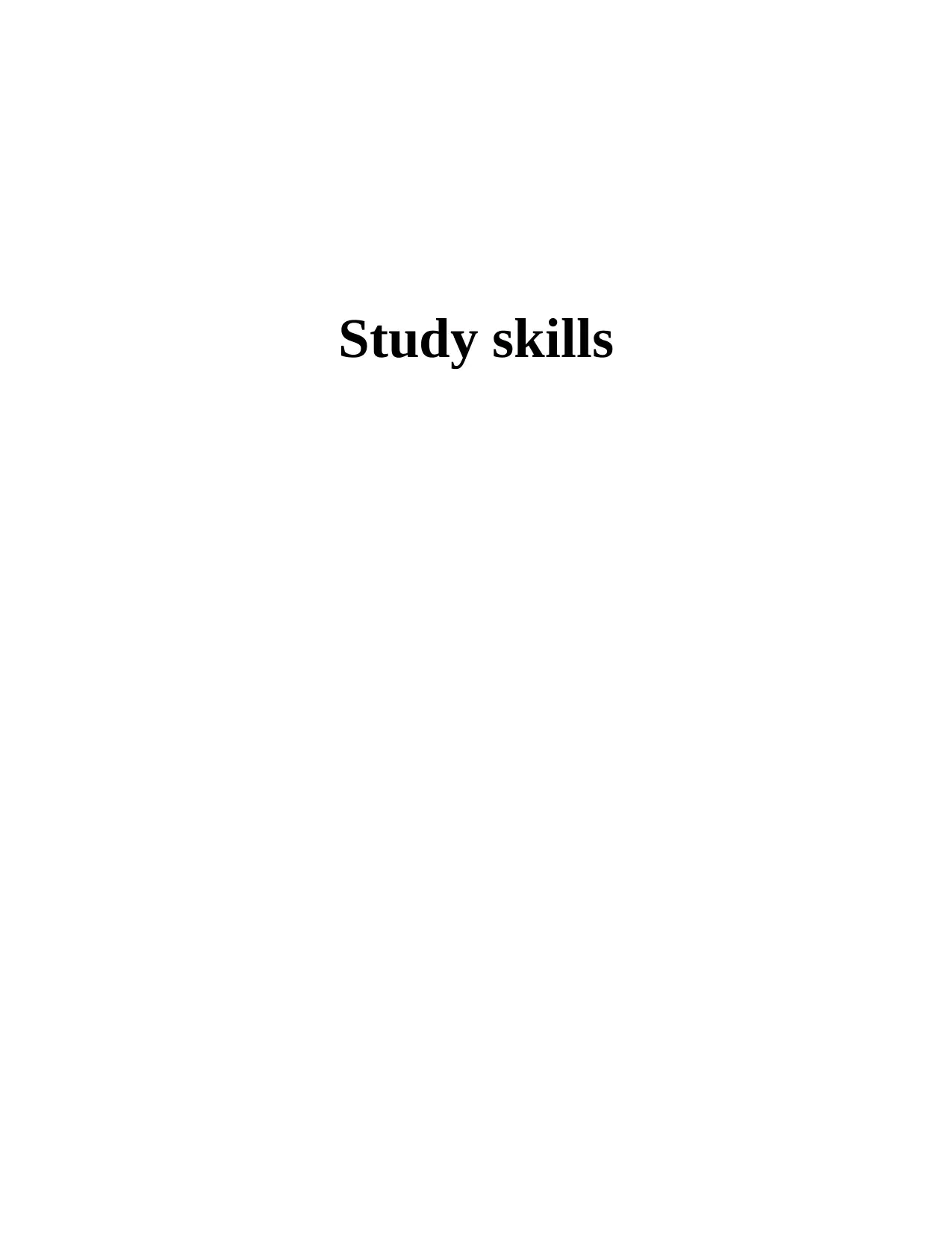
Study skills
Paraphrase This Document
Need a fresh take? Get an instant paraphrase of this document with our AI Paraphraser
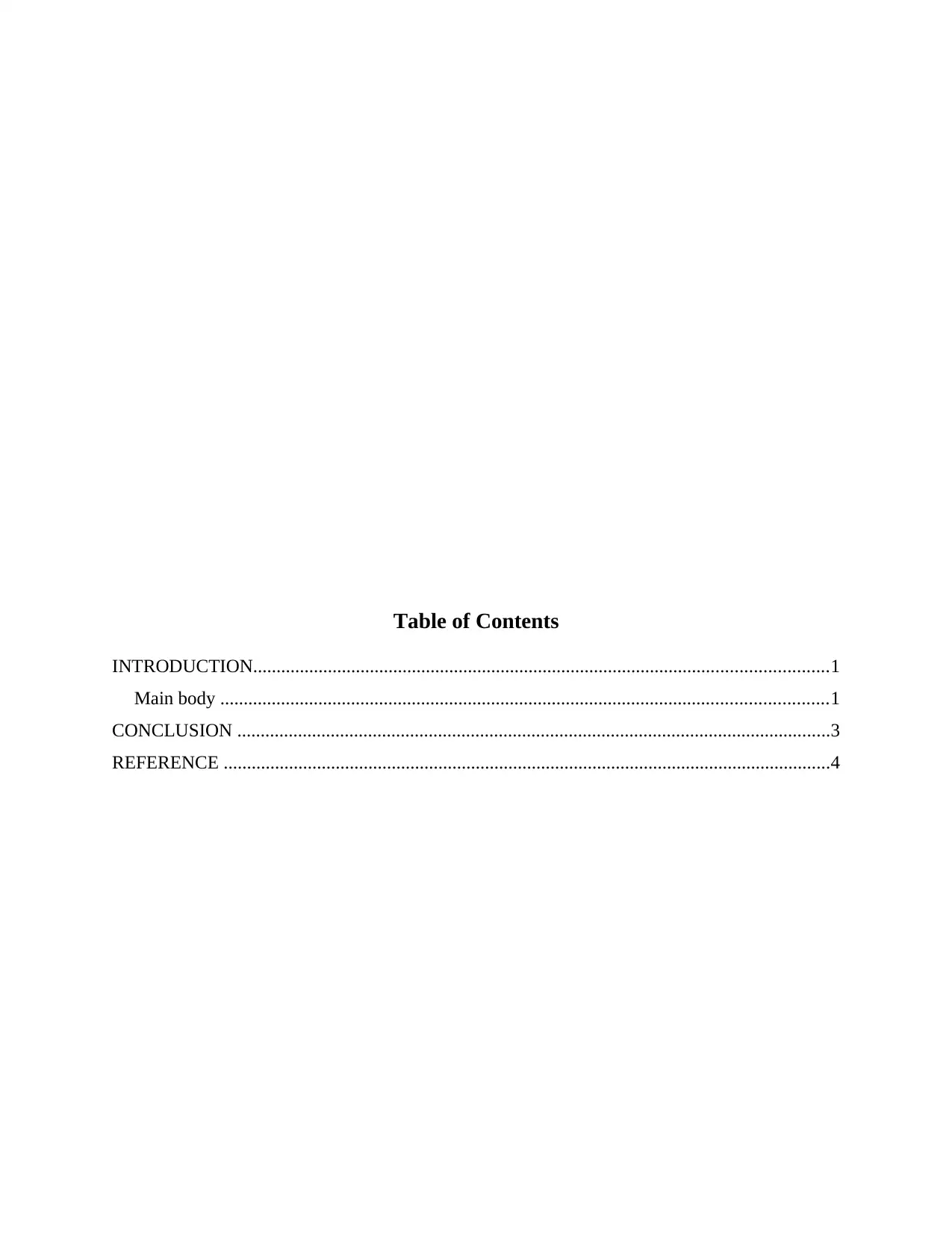
Table of Contents
INTRODUCTION...........................................................................................................................1
Main body ..................................................................................................................................1
CONCLUSION ...............................................................................................................................3
REFERENCE ..................................................................................................................................4
INTRODUCTION...........................................................................................................................1
Main body ..................................................................................................................................1
CONCLUSION ...............................................................................................................................3
REFERENCE ..................................................................................................................................4
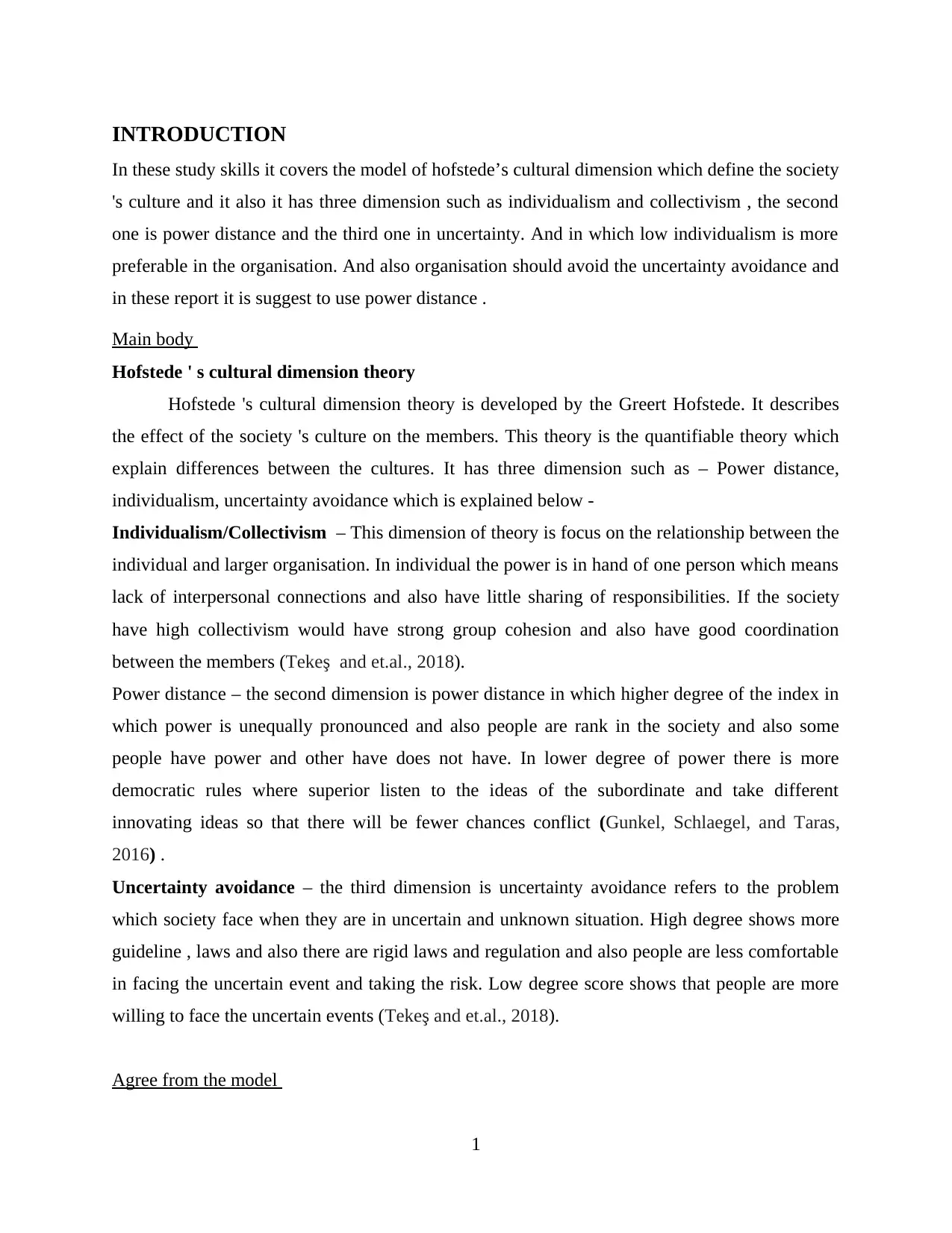
INTRODUCTION
In these study skills it covers the model of hofstede’s cultural dimension which define the society
's culture and it also it has three dimension such as individualism and collectivism , the second
one is power distance and the third one in uncertainty. And in which low individualism is more
preferable in the organisation. And also organisation should avoid the uncertainty avoidance and
in these report it is suggest to use power distance .
Main body
Hofstede ' s cultural dimension theory
Hofstede 's cultural dimension theory is developed by the Greert Hofstede. It describes
the effect of the society 's culture on the members. This theory is the quantifiable theory which
explain differences between the cultures. It has three dimension such as – Power distance,
individualism, uncertainty avoidance which is explained below -
Individualism/Collectivism – This dimension of theory is focus on the relationship between the
individual and larger organisation. In individual the power is in hand of one person which means
lack of interpersonal connections and also have little sharing of responsibilities. If the society
have high collectivism would have strong group cohesion and also have good coordination
between the members (Tekeş and et.al., 2018).
Power distance – the second dimension is power distance in which higher degree of the index in
which power is unequally pronounced and also people are rank in the society and also some
people have power and other have does not have. In lower degree of power there is more
democratic rules where superior listen to the ideas of the subordinate and take different
innovating ideas so that there will be fewer chances conflict (Gunkel, Schlaegel, and Taras,
2016) .
Uncertainty avoidance – the third dimension is uncertainty avoidance refers to the problem
which society face when they are in uncertain and unknown situation. High degree shows more
guideline , laws and also there are rigid laws and regulation and also people are less comfortable
in facing the uncertain event and taking the risk. Low degree score shows that people are more
willing to face the uncertain events (Tekeş and et.al., 2018).
Agree from the model
1
In these study skills it covers the model of hofstede’s cultural dimension which define the society
's culture and it also it has three dimension such as individualism and collectivism , the second
one is power distance and the third one in uncertainty. And in which low individualism is more
preferable in the organisation. And also organisation should avoid the uncertainty avoidance and
in these report it is suggest to use power distance .
Main body
Hofstede ' s cultural dimension theory
Hofstede 's cultural dimension theory is developed by the Greert Hofstede. It describes
the effect of the society 's culture on the members. This theory is the quantifiable theory which
explain differences between the cultures. It has three dimension such as – Power distance,
individualism, uncertainty avoidance which is explained below -
Individualism/Collectivism – This dimension of theory is focus on the relationship between the
individual and larger organisation. In individual the power is in hand of one person which means
lack of interpersonal connections and also have little sharing of responsibilities. If the society
have high collectivism would have strong group cohesion and also have good coordination
between the members (Tekeş and et.al., 2018).
Power distance – the second dimension is power distance in which higher degree of the index in
which power is unequally pronounced and also people are rank in the society and also some
people have power and other have does not have. In lower degree of power there is more
democratic rules where superior listen to the ideas of the subordinate and take different
innovating ideas so that there will be fewer chances conflict (Gunkel, Schlaegel, and Taras,
2016) .
Uncertainty avoidance – the third dimension is uncertainty avoidance refers to the problem
which society face when they are in uncertain and unknown situation. High degree shows more
guideline , laws and also there are rigid laws and regulation and also people are less comfortable
in facing the uncertain event and taking the risk. Low degree score shows that people are more
willing to face the uncertain events (Tekeş and et.al., 2018).
Agree from the model
1
⊘ This is a preview!⊘
Do you want full access?
Subscribe today to unlock all pages.

Trusted by 1+ million students worldwide
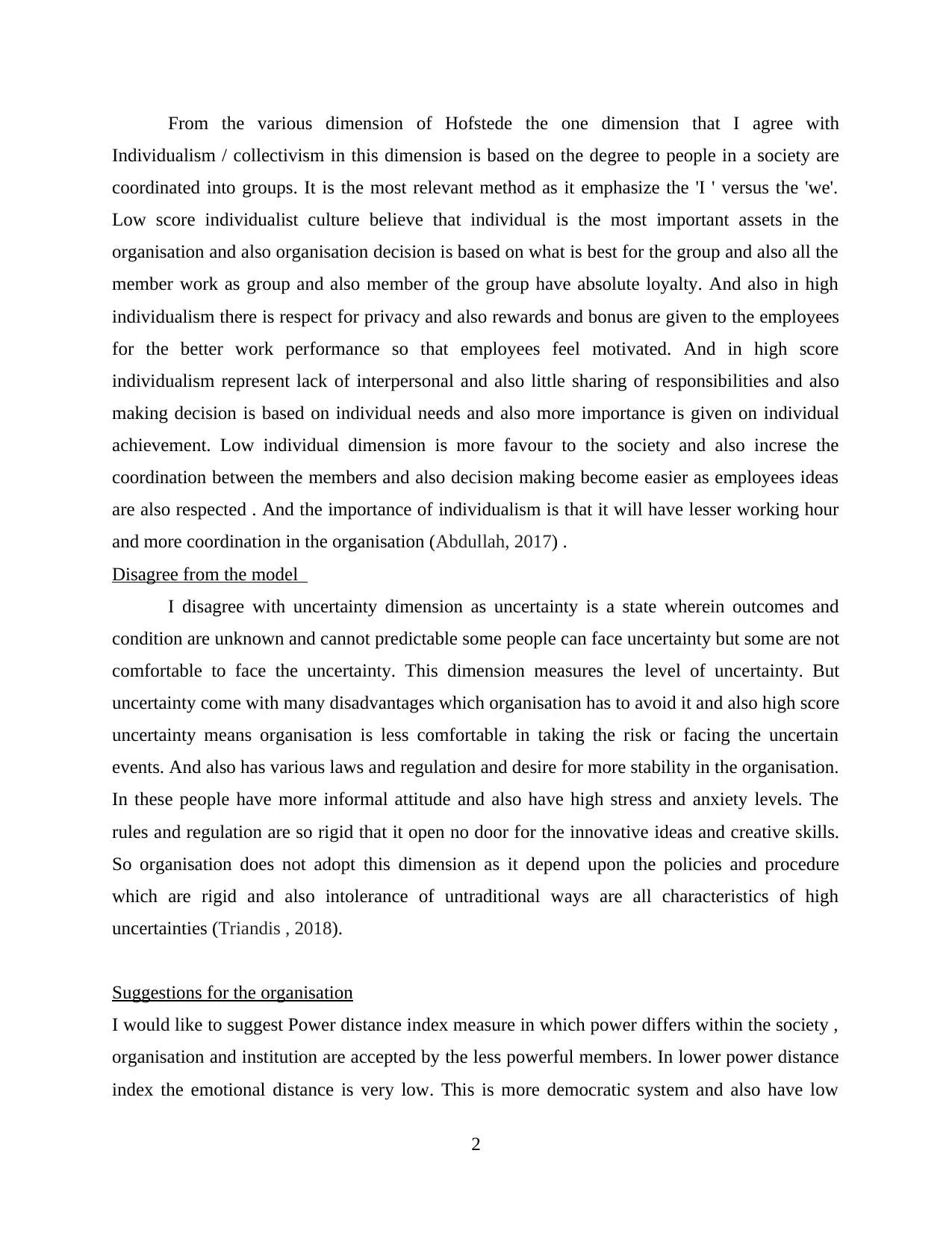
From the various dimension of Hofstede the one dimension that I agree with
Individualism / collectivism in this dimension is based on the degree to people in a society are
coordinated into groups. It is the most relevant method as it emphasize the 'I ' versus the 'we'.
Low score individualist culture believe that individual is the most important assets in the
organisation and also organisation decision is based on what is best for the group and also all the
member work as group and also member of the group have absolute loyalty. And also in high
individualism there is respect for privacy and also rewards and bonus are given to the employees
for the better work performance so that employees feel motivated. And in high score
individualism represent lack of interpersonal and also little sharing of responsibilities and also
making decision is based on individual needs and also more importance is given on individual
achievement. Low individual dimension is more favour to the society and also increse the
coordination between the members and also decision making become easier as employees ideas
are also respected . And the importance of individualism is that it will have lesser working hour
and more coordination in the organisation (Abdullah, 2017) .
Disagree from the model
I disagree with uncertainty dimension as uncertainty is a state wherein outcomes and
condition are unknown and cannot predictable some people can face uncertainty but some are not
comfortable to face the uncertainty. This dimension measures the level of uncertainty. But
uncertainty come with many disadvantages which organisation has to avoid it and also high score
uncertainty means organisation is less comfortable in taking the risk or facing the uncertain
events. And also has various laws and regulation and desire for more stability in the organisation.
In these people have more informal attitude and also have high stress and anxiety levels. The
rules and regulation are so rigid that it open no door for the innovative ideas and creative skills.
So organisation does not adopt this dimension as it depend upon the policies and procedure
which are rigid and also intolerance of untraditional ways are all characteristics of high
uncertainties (Triandis , 2018).
Suggestions for the organisation
I would like to suggest Power distance index measure in which power differs within the society ,
organisation and institution are accepted by the less powerful members. In lower power distance
index the emotional distance is very low. This is more democratic system and also have low
2
Individualism / collectivism in this dimension is based on the degree to people in a society are
coordinated into groups. It is the most relevant method as it emphasize the 'I ' versus the 'we'.
Low score individualist culture believe that individual is the most important assets in the
organisation and also organisation decision is based on what is best for the group and also all the
member work as group and also member of the group have absolute loyalty. And also in high
individualism there is respect for privacy and also rewards and bonus are given to the employees
for the better work performance so that employees feel motivated. And in high score
individualism represent lack of interpersonal and also little sharing of responsibilities and also
making decision is based on individual needs and also more importance is given on individual
achievement. Low individual dimension is more favour to the society and also increse the
coordination between the members and also decision making become easier as employees ideas
are also respected . And the importance of individualism is that it will have lesser working hour
and more coordination in the organisation (Abdullah, 2017) .
Disagree from the model
I disagree with uncertainty dimension as uncertainty is a state wherein outcomes and
condition are unknown and cannot predictable some people can face uncertainty but some are not
comfortable to face the uncertainty. This dimension measures the level of uncertainty. But
uncertainty come with many disadvantages which organisation has to avoid it and also high score
uncertainty means organisation is less comfortable in taking the risk or facing the uncertain
events. And also has various laws and regulation and desire for more stability in the organisation.
In these people have more informal attitude and also have high stress and anxiety levels. The
rules and regulation are so rigid that it open no door for the innovative ideas and creative skills.
So organisation does not adopt this dimension as it depend upon the policies and procedure
which are rigid and also intolerance of untraditional ways are all characteristics of high
uncertainties (Triandis , 2018).
Suggestions for the organisation
I would like to suggest Power distance index measure in which power differs within the society ,
organisation and institution are accepted by the less powerful members. In lower power distance
index the emotional distance is very low. This is more democratic system and also have low
2
Paraphrase This Document
Need a fresh take? Get an instant paraphrase of this document with our AI Paraphraser
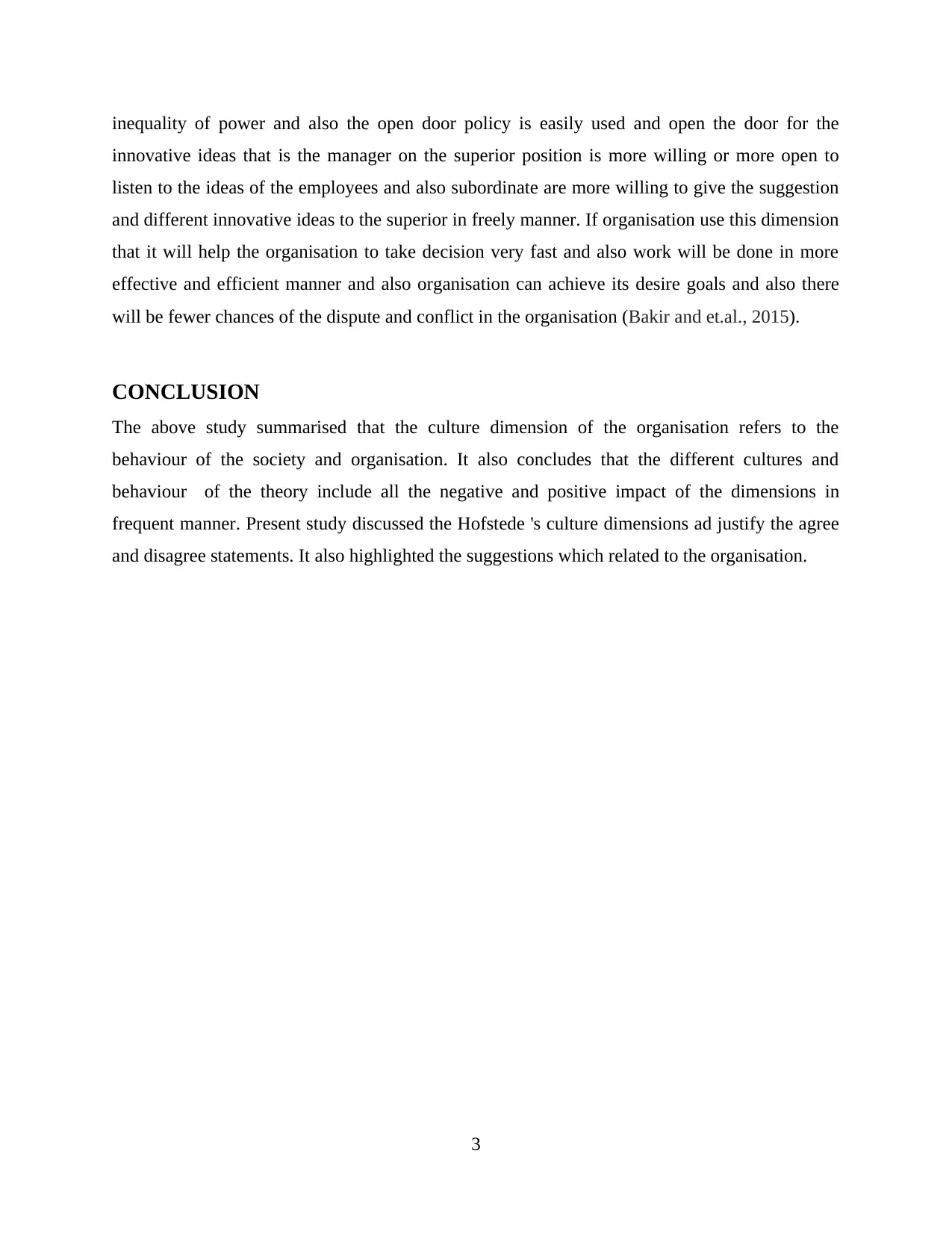
inequality of power and also the open door policy is easily used and open the door for the
innovative ideas that is the manager on the superior position is more willing or more open to
listen to the ideas of the employees and also subordinate are more willing to give the suggestion
and different innovative ideas to the superior in freely manner. If organisation use this dimension
that it will help the organisation to take decision very fast and also work will be done in more
effective and efficient manner and also organisation can achieve its desire goals and also there
will be fewer chances of the dispute and conflict in the organisation (Bakir and et.al., 2015).
CONCLUSION
The above study summarised that the culture dimension of the organisation refers to the
behaviour of the society and organisation. It also concludes that the different cultures and
behaviour of the theory include all the negative and positive impact of the dimensions in
frequent manner. Present study discussed the Hofstede 's culture dimensions ad justify the agree
and disagree statements. It also highlighted the suggestions which related to the organisation.
3
innovative ideas that is the manager on the superior position is more willing or more open to
listen to the ideas of the employees and also subordinate are more willing to give the suggestion
and different innovative ideas to the superior in freely manner. If organisation use this dimension
that it will help the organisation to take decision very fast and also work will be done in more
effective and efficient manner and also organisation can achieve its desire goals and also there
will be fewer chances of the dispute and conflict in the organisation (Bakir and et.al., 2015).
CONCLUSION
The above study summarised that the culture dimension of the organisation refers to the
behaviour of the society and organisation. It also concludes that the different cultures and
behaviour of the theory include all the negative and positive impact of the dimensions in
frequent manner. Present study discussed the Hofstede 's culture dimensions ad justify the agree
and disagree statements. It also highlighted the suggestions which related to the organisation.
3

REFERENCE
Abdullah, A.B.M., 2017. Cultural Context. In Managing the Psychological
Contract (pp. 23-41). Palgrave Macmillan, Cham.
Bakir, A. and et.al., 2015. A preliminary investigation of the reliability and
validity of Hofstede’s cross cultural dimensions. In Proceedings of the
2000 Academy of Marketing Science (AMS) Annual Conference (pp. 226-
232). Springer, Cham.
Gunkel, M., Schlaegel, C. and Taras, V., 2016. Cultural values, emotional
intelligence, and conflict handling styles: A global study. Journal of
World Business.51(4). pp.568-585.
Tekeş, B. and et.al., 2018. The Relationship Between Hofstede’s Cultural
Dimensions, Schwartz’s Cultural Values, and Obesity. Psychological
reports, p.0033294118777965.
Triandis, H.C., 2018. Individualism and collectivism. Routledge.
4
Abdullah, A.B.M., 2017. Cultural Context. In Managing the Psychological
Contract (pp. 23-41). Palgrave Macmillan, Cham.
Bakir, A. and et.al., 2015. A preliminary investigation of the reliability and
validity of Hofstede’s cross cultural dimensions. In Proceedings of the
2000 Academy of Marketing Science (AMS) Annual Conference (pp. 226-
232). Springer, Cham.
Gunkel, M., Schlaegel, C. and Taras, V., 2016. Cultural values, emotional
intelligence, and conflict handling styles: A global study. Journal of
World Business.51(4). pp.568-585.
Tekeş, B. and et.al., 2018. The Relationship Between Hofstede’s Cultural
Dimensions, Schwartz’s Cultural Values, and Obesity. Psychological
reports, p.0033294118777965.
Triandis, H.C., 2018. Individualism and collectivism. Routledge.
4
⊘ This is a preview!⊘
Do you want full access?
Subscribe today to unlock all pages.

Trusted by 1+ million students worldwide

5
1 out of 7
Related Documents
Your All-in-One AI-Powered Toolkit for Academic Success.
+13062052269
info@desklib.com
Available 24*7 on WhatsApp / Email
![[object Object]](/_next/static/media/star-bottom.7253800d.svg)
Unlock your academic potential
Copyright © 2020–2025 A2Z Services. All Rights Reserved. Developed and managed by ZUCOL.





